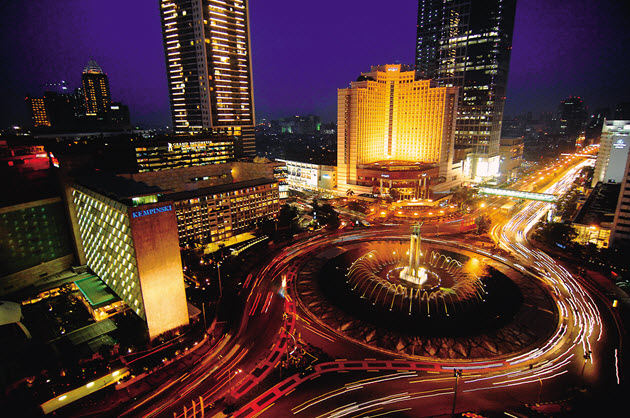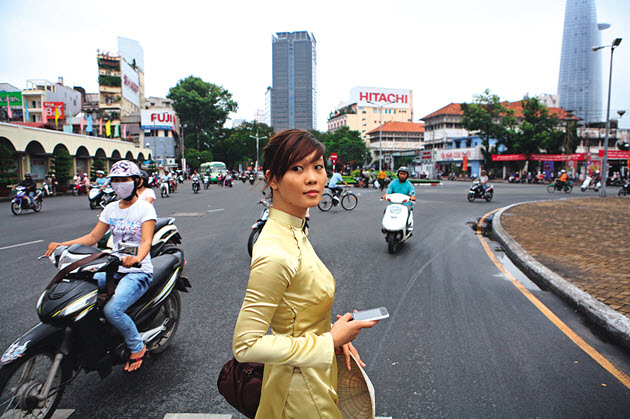Young, Bold and Confident
Indonesia, Vietnam: Asia's New Economic Stars

Source:Ming-Tang Huang
Indonesia is BlackBerry's fastest growing market in the world. Vietnam was chosen by Intel for its new US$1 billion wafer factory. How have these two countries become Asia's newest stars?
Views
Indonesia, Vietnam: Asia's New Economic Stars
By Hsiao-Wen Wang, Hsiang-Yi ChangFrom CommonWealth Magazine (vol. 458 )
The scene: a coffee shop in a modern shopping center in Jakarta. Nineteen-year-old Shiela and her friends are nursing their 30,000 rupiah (about US$3.35) cups of iced milk tea while keeping their eyes glued to their Blackberry smartphones as they rapidly pound out what may be their thousandth message of the day.
Shiela represents the consumer segment now being targeted by big multinational brands, such as Nokia, Swatch and Coca-Cola. This group of consumers in the 15-20 age bracket tend not to save or display personal independence, preferring instead to support brands favored by their friends. One Indonesian marketing expert describes these young spenders as "ABG," or "anak baru gede," meaning "kids who've just grown up," and it is they who form the backbone of the emerging middle class that will drive Indonesia's economic growth in the coming decade.
Another scene, this time along Dong Khoi, the premier shopping street in Vietnam's Ho Chi Minh City. Thirty-one year-old single mother Nguyen Phi Nhu and her friends brave a downpour to exercise their passion for shopping. Nguyen is a mid-level manager for the Ho Chi Minh City branch of multinational pharmaceutical Abbott S.A., and she also owns her own public relations firm.
These well-educated, high-income women employed by foreign companies pattern themselves after the main characters of the U.S. TV series Sex and the City, yearning for the same economic independence, freedom to consume and enjoyment of life exhibited by Carrie Bradshaw and her friends.For Indonesia and Vietnam, the times, indeed, are changing.
The archipelago of 10,000 islands endured a decade of suffering in the 1990s, dragged down by the dictatorship of then president Suharto, fierce ethnic clashes and the Asian Financial Crisis. But it has since rebounded, receiving kudos this year from the New York Times: "After years of inefficiency, Indonesia emerges as an economic model."

Torn asunder in the past by uninterrupted military conflict and now under the autocratic control of the Communist Party, Vietnam gained prominence in the eyes of global investors even earlier than Indonesia as a land of new opportunities.
In December 2005, investment bank Goldman Sachs named Vietnam as one of the "Next Eleven" economies expected to "be the next BRICS" of the 21st century, and in a research report in April 2008, the bank called Vietnam "the next Asian Tiger in the making." The Southeast Asian country was also included among the Economist Intelligence Unit's "CIVETS" (Colombia, Indonesia, Vietnam, Egypt, Turkey and South Africa), considered as emerging markets to watch over the next 10 years.
The 320 million people living in Indonesia and Vietnam have seen their lives change dramatically from the turmoil of the past to the robust economic growth of the present, a transition that has left them more confident than ever, despite the recent global financial crisis.
In the Nielsen Company's Global Consumer Confidence Survey for the second quarter of 2010, Vietnam and Indonesia had the second highest consumer confidence indexes of any countries in the world, trailing only India, and they were ranked first and second, respectively, for consumer confidence in the under-30 age bracket.
Indonesia and Vietnam, young, confident, and seemingly oblivious to the dangers of the global economy's sluggishness, are the newest stars illuminating Asia's horizons.
Of the four BRICs (Brazil, Russia, India and China), only China and India experienced strong economic growth in turbulent 2009. Growth rates of 4.5 percent in Indonesia and 5.3 percent in Vietnam far outpaced the negative growth seen in Brazil and Russia.
With both countries expected to grow by over 6 percent in 2010, multinational corporations and investment banks are pouring in, sending foreign direct investment (FDI) soaring again. Indonesia's stock market has risen 40 percent this year, the highest in Asia.
Two major factors have enabled these two stars to shine brightly in the night: China's economic restructuring and the rise of a new Asian Way.
Factor No. 1: China Changing Course
"When China raises its wages, we see manufacturers start to relocate. We benefit a lot from the relocation," admits Mari E. Pangestu, Indonesia's trade minister, in a recent interview with CommonWealth Magazine. But to take full advantage of the opportunity, Indonesia must adjust its own policies as China restructures and open its arms to welcome foreign manufacturers, she says, confident her country will meet the challenge.

"But it's not like that kind of foot-loose relocation. They don't move just because later on labor will get cheaper somewhere else – in Africa, Latin America. The pattern is changing. They are diversifying their production in different areas, and for different specializations. I think it [Indonesia] has become more specialized and the best place for them in the global value chain," says Pangestu in fluent English. Indonesia's stable supply of labor, growing domestic demand, and continuing political reforms all have factored into foreign companies' decision to develop a presence there.
In its report "Asia Macro Views" released this September, Citigroup argued that with wages in China rising 15-20 percent, Beijing would imitate the roads taken by Taiwan and South Korea in the 1980s to upgrade their economies, and that would leave Indonesia and Vietnam among the winners in the resulting shake-up of Asia's manufacturing chain.
As Indonesia and Vietnam boast minimum wages merely a third of what Foxconn Technology Group (aka Hon Hai) pays its employees in China, they will be the countries that absorb the manufacturers leaving the Middle Kingdom.
The Biggest Foreign Investor: Taiwan
Taiwanese companies, which have been active around the world, have long been Vietnam's biggest "real" source of FDI.According to Vietnam's statistics bureau, South Korea and Japan rank ahead of Taiwan as FDI sources.
"But that's because when Taiwanese companies first started investing in Vietnam, they invested through Hong Kong or offshore companies or even Vietnamese companies," Ho Quoc Phi, deputy representative of Vietnam Economic and Cultural Office in Taipei, explains in fluent Chinese.
"Taiwanese businesses have invested more than US$20 billion in Vietnam. There is no doubt that Taiwan is one of our most important partners," he says.
Many Taiwanese businessmen operating abroad are now paying even more attention to Indonesia.
When Taiwan's economics minister Shih Yen-shiang took a rare session off from reporting to the Legislature at the beginning of October, it was to lead a trade and investment delegation of more than 100 people to Indonesia, the biggest delegation Taiwan had sent there in recent memory. Joining the group were the chairman of the Taiwan Electrical and Electronic Manufacturers' Association, Arthur Chiao, and Teco Group chairman Theodore Huang.
Taking advantage of the easing of the global credit crisis and the emergence of a new Asia, many multinational corporations have also moved into or expanded their presences in the two countries.
In June this year, Nissan Motor Company, Japan's third-largest carmaker, announced it would invest US$20 million to double its annual car production in Indonesia to 100,000 vehicles in three years and increase sales there from 20,000 units in 2009 to 90,000 units. Global shoe giant Reebok also plans to expand capacity in the country. The Taiwan-based Pou Chen Group, which already ranks as the biggest foreign enterprise in Indonesia, is expecting to increase its work force to 120,000 employees, from 70,000 at present.
As for Vietnam, Intel, the world's biggest chip maker, announced in July it would invest US$1 billion to build a new foundry there.
They are just a few of the growing numbers of international companies flooding into the two countries.
Factor No. 2: The Emergence of a New Asian Way
The second factor helping Vietnam and Indonesia gain attention is the rise of a new Asian Way, dictated by the need to overhaul Asia's export-oriented growth model to cope with an anticipated prolonged period of economic sluggishness in Europe and the United States.
The latest report from the Asian Development Bank asserted that Asia's manufacturing network must phase out its export-oriented model and focus on domestic demand. The new Asian Way will no longer concentrate on vertical integration to serve the European and American markets, but will instead emphasize horizontal integration among Asian countries to serve the region's own end-markets.
The Youngest Domestic Demand Markets
Indonesia and Vietnam, with populations of 230 million and 86 million people, are among Asia's most dynamic countries, bursting with vitality. That's why foreign enterprises consider the two countries, along with China, to be "future markets" that cannot be ignored. Over 45 percent of their population falls in the 15-29 age bracket, amounting to nearly 100 million people, and many are avid consumers.

Nowhere is that enthusiasm for spending money more evident than at Jakarta's upscale shopping centers, including the Pacific Place Mall, where Taiwan-based DinTaiFung restaurant has an outlet that has built a loyal following among members of this emerging middle class. R. Survander, a 28-year-old wedding planner, and his friends, for instance, visit the restaurant twice a week, spending over 200,000 rupiah (US$22) each time.
In both Indonesia and Vietnam, there are a growing number of young people such as Survander who have no inhibitions about consuming.
The middle class will soon grow rapidly, predicts Robby Susatyo, the managing director of the Indonesian branch of global market research firm Synovate. Half of Indonesia's population spends between 1 million and 2 million rupiah (US$112 to US$224) a month, often going through their wages soon after collecting them. But since President Susilo Bambang Yudhoyono took over as president six years ago, the number of consumers spending between 2 million and 3 million rupiah per month has been growing.
Confident in the Future, Eager to Spend
Even though young people in Vietnam and Indonesia have average incomes far lower than in Europe and the United States, they are seemingly unafraid to consume. According to Chris Von Selle, CEO of advertising agency JWT Vietnam, who has also lived in Malaysia, the Philippines and Dubai, this is because they have never experienced the conflict of war, and they were also not really affected by the first Asian Financial Crisis in 1997. "Most of them only know one direction—and that is 'up'," he asserts.

A common trait among these emerging middle class consumers is their passion for high-tech gadgets and international brands. Though it may be hard to believe, BlackBerry's fastest growing market in the world is Indonesia, with the number of units sold growing four-fold in 2009 and doubling this year. In this archipelago with the world's fourth biggest population, BlackBerry has defeated the king of smartphone brands, the iPhone. According to a CNN report, small mobile phone retailers in Jakarta sell only one iPhone a day, compared to five BlackBerry smartphones that, for a fee of US$20 a month, allow users to surf the Internet and chat.
Such a phenomenon is not unique. The biggest market for social networking leader Facebook outside the United States is also Indonesia. In the past three years, Facebook has amassed over 25 million Indonesian users, exceeding Taiwan's entire population.
"The younger generation seek their identity through buying. They are less individualistic, more communal," observes Achjuman Achjadi, the CEO of advertising agency Carat Indonesia.
Private consumption accounts for 60 percent of Indonesia's economy and 40 percent of Vietnam's economy, and unlike in Taiwan, it is a key engine of growth in both countries.
As urbanization accelerates, a middle class consisting of more than 100 million people with annual per capita income exceeding US$5,000 is being born. In this post-financial crisis era, Asia's newest economic stars are poised to take off.
Translated from the Chinese by Luke Sabatier






